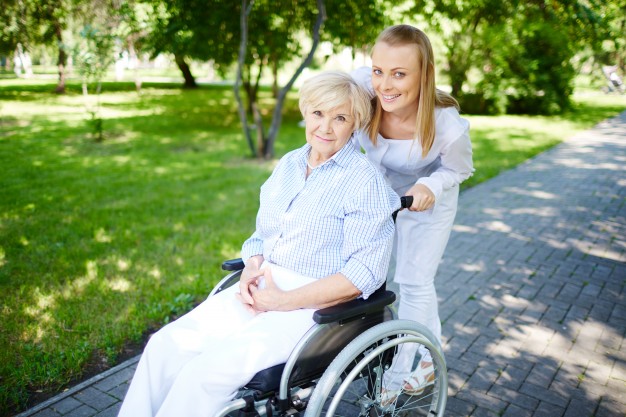
Osteoporosis is a degenerative disease of the bones usually caused by loss of tissue, typically as a result of hormonal changes, or deficiency of calcium or vitamin D. It is sometimes called a “silent disease” because most people do not know they have it until they have a fracture. As we grow older, the density of the bones begins to decrease. This is why seniors are mostly prone to fractures. Whereas, broken bones can lead to serious problems for seniors. They usually suffer osteoporosis in the hip, and hip fractures can lead to a downward spiral of disability as a result making them depend on their loved ones for mobility. Osteoporosis can also occur in the wrist and the spine.
It was reported that women suffer osteoporosis more than men. This is because a woman’s estrogen levels which help to make and rebuild bones drop after menopause, and this speeds up bone loss. That is why osteoporosis is most common among older women than older men.
CAUSES OF OSTEOPOROSIS IN THE SENIORS
There are a variety of risk factors causing osteoporosis in the seniors. Some can be worked upon while some cannot be changed. The following are such factors:
RISK FACTORS THAT CANNOT BE CHANGED
GENDER :The chances of older women developing osteoporosis are significantly higher. This is because the changes that happen with menopause cause them to lose bone faster than men. Nevertheless, older men do suffer osteoporosis.
BODY SIZE: Seniors with small and thin bones are at greater risk
AGE : As one grows older, the greater the risk of osteoporosis. This is because the bones become thinner and weaker with age.
ORIGIN : Asian and Caucasian women have the highest risk while African American and Hispanic women have a lower but still significant risk
GENEALOGY : Osteoporosis can be linked with hereditary as those whose parents have a history of fractures also seem to have reduced bone density and may be at risk of fracture.
RISK FACTORS THAT CAN BE CHANGED
ANOREXIA NERVOSA: Restricting amount of one’s food intake for fear of gaining weight. This eating disorder increases the risk of osteoporosis in the elderly loved ones but can be avoided.
SMOKING: Smoking cigarettes is bad for bones which can increase the risk of osteoporosis in the seniors
LIFESTYLE: Leading a sedentary lifestyle possibly after retirement or staying in bed for long tends to weaken bones
ALCOHOL: – Seniors consuming alcohol excessively increases their risk of bone loss and fractures.
MEDICATION : Taking anticonvulsants for a long period of time can lead to loss of bone density and fractures.
CHALLENGES SENIORS WITH OSTEOPOROSIS FACE
One can rightly say age, hormone deficiencies, illness and a sedentary lifestyle are the leading causes of bone loss. Weak bones make the day-to-day activities increasingly difficult for seniors living with osteoporosis and this comes with a number of challenges. Let’s consider some of the challenges seniors living with osteoporosis face.
MOBILITY RESTRICTIONS:
Seniors suffering from osteoporosis go through severe pain which makes mobility difficult for them. Unfortunately, limited mobility makes osteoporosis worse and can cause other health problems as well.
HEAVY FINANCIAL COST
Treating Osteoporosis can be expensive. Pitifully, some seniors suffering from the disease might not be financially buoyant enough to carry such high cost.
PAIN
Bone fractures are painful. Seniors with osteoporosis often go through chronic pain.
DEPRESSION
Seniors with osteoporosis often suffer feelings of isolation because of pain and mobility restrictions. The financial burdens also have effects on their sense of well-being. All these bring about depression in the seniors.
CARING FOR SENIORS WITH OSTEOPOROSIS
Caring for seniors with osteoporosis can be demanding and challenging nevertheless, they need love and care from their families and caregivers. There might not have been a cure for osteoporosis, but there are ways to slow the progression and prevent the worst complications of the disease. For seniors battling with osteoporosis, giving them health care at home is an important aspect of helping them maintain quality life. Letting them remain in the comfort of their home has salutary value beyond any other form of medicine.
Here are some tips families and caregivers can employ to improve the quality of life for the seniors living with osteoporosis:
-
MAKE A NUTRITION PLAN
Caregivers and families of seniors with osteoporosis should scheme out a good nutrition plan rich in calcium and vitamin D since calcium and vitamin D deficiencies are among the leading causes of bones loss. Good nutrition is of great importance in slowing down the progression of osteoporosis in the elderly loved ones. Care providers should also ensure that medications are given in appropriate doses at the appropriate times
-
REGULAR TREATMENT
Caregivers should ensure the seniors with osteoporosis are regularly receiving quality medical care. If not properly monitored and adequately treated, osteoporosis can dramatically worsen which may aggravate the patient’s discomfort. The senior involved should also be advised to explore all options provided by their physician or orthopedic doctor. Regular bone density scans will also help the caregiver evaluate the progression of the disease and determine whether the selected treatment is working effectively or not.
-
SHOW THEM LOVE
Living with osteoporosis can have a serious mental effect on the seniors especially when they have to depend on their loved ones for mobility. Caregivers should provide companionship and compassionate care for them to help them maintain a sense of well-being. It should also be noted that the regular presence of a caregiver gives the senior the opportunity to accomplish things they might not be able to do on their own.
-
LIFESTYLE ASSISTANCE
Seniors living with osteoporosis will need to make some adjustments in their choices of lifestyle in order to keep their bones as healthy as possible. Adjustment such as limiting the intake of alcohol, abstaining from smoking cigarettes and wholly following the already planned out diet. Caregivers should help seniors make these important changes.
-
HELP TO AVOID FALLS
Leaving hazardous materials such as broken chairs, broken handrails, loose wires and carpets or other sharp objects around or in the way of seniors with osteoporosis pose potential dangers to them. They should be removed. Icy, wet, or slippery surfaces should also be done away with to avoid falls that can lead to fractures.
CONCLUSION
Aging and osteoporosis can create a significant amount of stress for seniors and their loved ones. Caring for seniors struggling with osteoporosis often means giving up at least some degree of independence, and the need for assistance only increases as the individual gets older. Nevertheless, they should be consistently and adequately taken care of. The love and support they receive from their loved ones, help them stay socially engaged, give them a greater sense of purpose and help create a safe and loving environment for them to live in.

